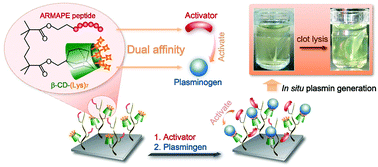Surfaces having dual affinity for plasminogen and tissue plasminogen activator: in situ plasmin generation and clot lysis†
Abstract
Surface modification with affinity ligands capable of capturing bioactive molecules in situ is a widely used strategy for developing biofunctional materials. However, many bioactive molecules, for example zymogens, exist naturally in a “quiescent” state, and become active only when “triggered” by specific activators. In the present study, in situ activation of a surface-integrated zymogen was achieved by introducing affinity ligands for both the zymogen and its activator. Specifically a dual affinity surface was designed for the integration of plasminogen (Plg) and tissue plasminogen activator (t-PA). This surface was expected to have plasmin-generating and, therefore, fibrinolytic properties. A polyurethane surface was modified with a copolymer of 2-hydroxyethyl methacrylate and 1-adamantan-1-ylmethyl methacrylate poly(HEMA-co-AdaMA). The affinity ligands, ARMAPE peptide (for t-PA) and ε-lysine-containing β-cyclodextrin (β-CD-(Lys)7) (for Plg), were attached in sequence via covalent bonding and host–guest interactions, respectively. The resulting surfaces were shown to have high binding capacities for both t-PA and Plg while resisting nonspecific protein adsorption. Pre-loading with t-PA followed by Plg uptake from plasma generated plasmin and thus endowed the surface with fibrinolytic activity. In general the incorporation of dual affinity ligands to achieve surface-promoted bioactivity is a promising approach for the development of biofunctional materials. The method reported herein for the sequential attachment of plasminogen and t-PA affinity ligands can be extended to systems of multiple ligands generally.


 Please wait while we load your content...
Please wait while we load your content...